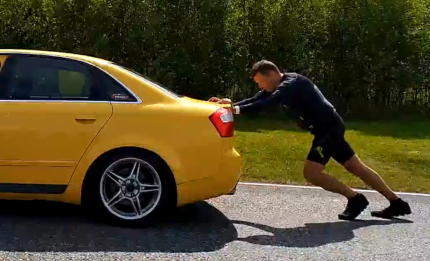"A normal middle-aged man can take on a world record challenge if they take everything into account and try to get the car rolling as lightly as possible”, told new Guinness World Record holder, Jussi Kallioniemi, to Motor1 after successful push. Kallioniemi pushed his 2006 Saab SUV through the course in 13 minutes and 26 seconds, thus improving the previous record by approximately two minutes. The record was result of optimization in training, in pushing as well as in the car’s rolling resistance.
Let’s have a closer look how he prepared for the challenge and how was the record push performed.
The training progress started already in summer 2019 and it was monitored regularly. Jussi used Myontec’s ErgoShirt and Mbody MShorts with MCell dataloggers during his training to optimize strength & conditioning training and pushing technique.
Before the training period Jussi’s reference values for each muscle group were recorded using “Maximum voluntary contraction” (MVC) method for upper body and lower body muscles. Data was recorded and analyzed in Myontec ErgoAnalysis software.
Upper body and lower body muscle loading profile was analyzed during the training performance. The graph shows both upper and lower body loads simultaneously during record performance:

In the beginning, getting the car moving required very strong use of the upper body.
Once the car was in motion, the loadings remained constant almost to completion of the trial.
At the very end of the trial the final sprint effort is clearly visible.
When having closer look at the upper body muscles loading profile during the performance, we see optimized loading distribution excluding only biceps.
The load on the left arm was evenly distributed over all the muscles, but on the right arm the biceps worked harder in relation to the shoulder (Deltoid) muscle. This was mainly due to round track where record push was performed.
Near the end of the performance, a few load spikes were observed in the upper body due to. At this stage Jussi knew that new record is coming so cheering up and extra push was visible in the load immediately.
Final sprint - as pushing sprints in generally - increased the upper body load more than lower body.
Leg muscles loading profile during the performance
Overall leg muscle loading:
During the first two laps, the loading slightly decreased due to adaptation.
In the middle phase the loading remained stable (“cruising speed”).
At end of the performance, the loading starts to increase partly due to fatigue and partly due to effort to focus on final sprint.
The loading distribution at legs:
The loading on the legs was evenly distributed over all the muscles during most laps.
At end of the performance, the Quads muscles turned imbalanced, more on the left side.
Analysis of the record push
So, at the beginning of the record push, the muscle activity corresponded to about 41% of Jussi's MVC. In the middle stages of the performance, Jussi used his muscles about 35%, and in the final stages again with the same power as in the beginning. The right side of the body (front and back thigh and gluteus muscles) did a little more work. This tells about body’s muscle balance but probably the circular shape of the track and the clockwise rotation. This is also supported by the fact that the difference is bigger after the starting line when he completed the whole round.
The muscle load remained moderate (about 35-40% of the maximum), which allowed for a smooth performance and didn't cause severe muscle fatigue in the first half of the push. Proportioned to the push speed / pace, the last two rounds showed an increase in muscle activity, indicating an increase in muscle fatigue. However, the pace didn't slow down, which is why Jussi has been very successful in regulating the force during performance.
"I believe the Myontec suite of products and help from Myontec provided me with a crucial 'strategic edge'. I benefited from the data and analysis especially in the early training place: made changes to my training, pushing posture and how I utilized muscles during the training. It opened my eyes to to what I needed to change. In short: as result I pushed the mile faster," summarized New Guinness World record holder his one year project.
"Overall, the data shows that the training was successful. Jussi has been able to implement optimized training into car push using only 35-40% of maximum power, which enables endurance-type performance", summarized Heidi Jarske, Myontec specialist.




























Komentari